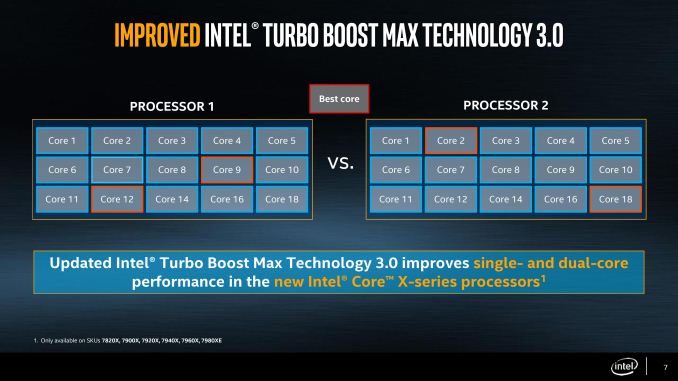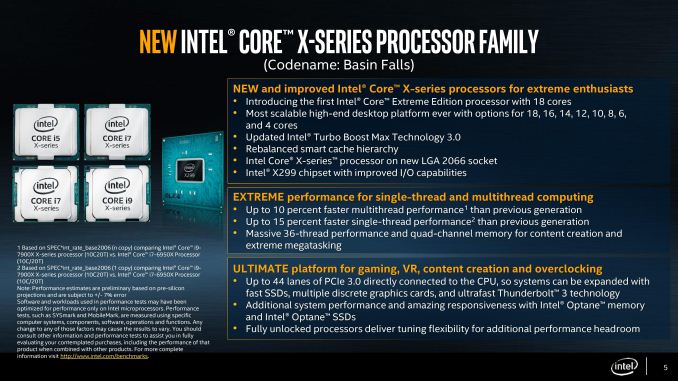Intel Announces Skylake-X: Bringing 18-Core HCC Silicon to Consumers for $1999
by Ian Cutress on May 30, 2017 3:03 AM ESTAnnouncement Four: AVX-512 & Favored Core
To complete the set, there are a couple of other points worth discussing. First up is that AVX-512 support coming to Skylake-X. Intel has implemented AVX-512 (or at least a variant of it) in the last generation of Xeon Phi processors, Knights Landing, but this will be the first implementation in a consumer/enterprise core.
Intel hasn’t given many details on AVX-512 yet, regarding whether there is one or two units per CPU, or if it is more granular and is per core. We expect it to be enabled on day one, although I have a suspicion there may be a BIOS flag that needs enabling in order to use it.
As with AVX and AVX2, the goal here is so provide a powerful set of hardware to solve vector calculations. The silicon that does this is dense, so sustained calculations run hot: we’ve seen processors that support AVX and AVX2 offer decreased operating frequencies when these instructions come along, and AVX-512 will be no different. Intel has not clarified at what frequency the AVX-512 instructions will run at, although if each core can support AVX-512 we suspect that the reduced frequency will only effect that core.
With the support of AVX-512, Intel is calling the Core i9-7980X ‘the first TeraFLOP CPU’. I’ve asked details as to how this figure is calculated (software, or theoretical), but it does make a milestone in processor design. We are muddying the waters a bit here though: an AVX unit does vector calculations, as does a GPU. We’re talking about parallel compute processes completed by dedicated hardware – the line between general purpose CPU and anything else is getting blurred.
Favored Core
For Broadwell-E, the last generation of Intel’s HEDT platform, we were introduced to the term ‘Favored Core’, which was given the title of Turbo Boost Max 3.0. The idea here is that each piece of silicon that comes off of the production line is different (which is then binned to match to a SKU), but within a piece of silicon the cores themselves will have different frequency and voltage characteristics. The one core that is determined to be the best is called the ‘Favored Core’, and when Intel’s Windows 10 driver and software were in place, single threaded workloads were moved to this favored core to run faster.
In theory, it was good – a step above the generic Turbo Boost 2.0 and offered an extra 100-200 MHz for single threaded applications. In practice, it was flawed: motherboard manufacturers didn’t support it, or they had it disabled in the BIOS by default. Users had to install the drivers and software as well – without the combination of all of these at work, the favored core feature didn’t work at all.
Intel is changing the feature for Skylake-X, with an upgrade and for ease-of-use. The driver and software are now part of Windows updates, so users will get them automatically (if you don’t want it, you have to disable it manually). With Skylake-X, instead of one core being the favored core, there are two cores in this family. As a result, two apps can be run at the higher frequency, or one app that needs two cores can participate.
Availability
Last but not least, let's talk about availability. Intel will likely announce availability during the keynote at Computex, which is going on at the same time as this news post goes live. The launch date should be sooner rather than later for the LCC parts, although the HCC parts are unknown. But no matter what, I think it's safe to say that by the end of this summer, we should expect a showdown over the best HEDT processor around.


















203 Comments
View All Comments
FwFred - Thursday, June 1, 2017 - link
My company paid for a dual 10 core Ivy Bridge Xeon workstation for me and every one of my coworkers. We'd save money moving to the 18 core i9s on the next round.PrazVT - Wednesday, May 31, 2017 - link
I totally whiffed on this announcement. I JUST ordered a 6800k / mobo / etc that are coming in tomorrow. Wanted to upgrade from my Core i7 970 system (a GPU upgrade from my old GTX 770 SLI setup later). Presumably I should return the cpu and mobo immediately and wait for the 7800x?Notmyusualid - Thursday, June 1, 2017 - link
It depends if you got a good deal on it...The 6800K will feel like night & day compared to your Gen 1 proc.
But I feel another 20 to 30% IPC is heading our way...
The question remains, was it a good deal? If the answer was yes, then continue.
Also, can you wait? This will be half a year away (I expect). If the answer is no, then continue with with you have again.
You can push that 6800K hard, reward it with a liquid cooler. Even if its just a Closed Loop affair, get a 240mm.
Lolimaster - Thursday, June 1, 2017 - link
Maybe simply go for the Ryzen 7 1700X?Way better cpu than the 7800X for the same money.
AGS3 - Thursday, June 1, 2017 - link
i9 is just a branding scheme to combat the Ryzen pressure. The i9's will just be the high end desktop parts that are Xeon's with ECC removed and repackaged. It is nothing different than prior high-end desktops which were labeled i7 with an X at the end. They do not have integrated graphics.GeoffreyA - Thursday, June 1, 2017 - link
It's a bit like the Pentium 4 Emergency Edition.GeoffreyA - Thursday, June 1, 2017 - link
Ryzen is very much like a new Athlon or Athlon 64.Ro_Ja - Thursday, June 1, 2017 - link
AMD's got them by the balls. It's just a matter of how much profit will Intel get with these new product.SaturnusDK - Thursday, June 1, 2017 - link
A late comment and no one will read it but as I see it even if Intel gets the 12-18 cores models out the door which still remains to be seen.Then it will still most likely be hampered by an ineffective inter-core connect. I didn't hear it mentioned anywhere but if the Xeon processors are anything to go by then the high core count models will be realized by stitching two cores together with the interface used between sockets. And as anyone who has ever used a dual Xeon workstation knows that two Xeons aren't anywhere near twice as fast as a single Xeon. The increase is 50% better on average.
Furthermore it looks to be hampered by a very low TDP. So it looks like while Intel might win the core count battle based on a paper launched product, the performance crown might actually still be in the hands of AMD. It'll certainly be extremely close in performance. Price however is likely to be twice as high as a comparable AMD product.
Also, 44 PCI-E lanes only for the top range products? And it caps at 44 lanes? What the hell are you thinking Intel? That's just crippling any hope of ever being competitive with AMD in this market segment you might have had.
FwFred - Thursday, June 1, 2017 - link
If you think the penalty paid by the dual ring bus in the HCC die is too high, you really won't like the AMD solution.